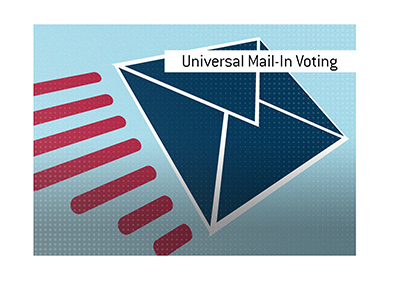Definition of Universal Mail-In Voting
What does the term "universal mail-in voting" mean? What is the definition of the term "universal mail-in voting", and how does it different from absentee voting?
"Universal mail-in voting" has become a key issue in the 2020 Presidential election.
 Here is what President Trump had to say about "universal mail-in voting":
Here is what President Trump had to say about "universal mail-in voting":"Universal mail-in voting is going to be catastrophic. It's going to make our country a laughingstock all over the world. You can't send out millions of ballots."
According to President Trump, universal mail-in voting will allow the Democrats to "rig" the election.
According to the Democrats, President Trump simply doesn't like universal mail-in voting as it tends to tip the scales in favor of the Democrats (as evidenced by the 2016 Presidential election, when the counting of mail-in ballots and absentee ballots after the election increased Hillary Clinton's popular vote margin).
-
So what is the difference between universal mail-in voting and absentee voting?
It's simple:
With absentee voting, you request a ballot because you will be unable to make it to your normal polling station for some reason. A ballot is usually mailed out to you, where you fill out the ballot and return it via mail.
This is how President Trump votes, and he has said that he has no problem with absentee ballots.
With universal mail-in voting, EVERYBODY is mailed their ballot.
Eight US states - including Colorado and Washington - will utilize a system that is almost entirely vote-by-mail for the 2020 US Presidential election. This number has grown due to the Coronavirus.
34 US states will allow voters to request mail ballots without providing a reason, while the remaining 8 US states (including Kentucky and Texas), will allow people to vote by mail, though they will need a reason as to why they are doing so.
Each state can set their own rules for how the election will be run, and a number of states have made changes due to the Coronavirus.
-
Let's pick one state that has vote-by-mail to see how it works. Let's pick the state of Oregon.
Oregon does NOT offer in-person voting.
On November 3rd, 1998, Oregon became the first state to conduct elections exclusively by mail when Ballot Measure 60 was passed into law by a vote of 69.4% to 30.6%.
Supporters of the bill said that it would increase voter participation and save the state money, while detractors of the bill said that it would encourage fraud.
Anyways, a few weeks before the election, Oregon mails ballots out to all of its registered voters. Voters can then fill out the ballots and return it via mail or a designated drop box.
People who live in Oregon can also pick up a ballot in person, though there is no voting at polling stations.
This is how universal mail-in voting works.
Absentee voting, on the other hand, is when you request a ballot by mail because you won't be able to make it to a polling station.
-
As mentioned, President Trump believes that universal mail-in voting is subject to fraud.
For instance, if a ballot was erroneously mailed to somebody that is now deceased, somebody could intercept the ballot, fill out the ballot and return it in the mail.
Proponents of this system believe that it dramatically increases voter participation, though nobody would argue that the system is perfect.
--
Davemanuel.com Articles That Mention Universal Mail-In Voting:
None
